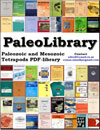
Complete Data Base of Paleozoic and Mesozoic Tetrapods.
Paleo-News and illustrations. Big electronic PDF-library.
| |
| PaleoNews |
| Classification |
| Books and Articles |
| Contact |
| Forum |
сайт о динозаврах
рейтинг сайтов
Free Counter
myspace hit counter
An Unusual New Theropod with a Didactyl Manus from the Upper Cretaceous of Patagonia, Argentina. |
July 22 , 2016 Background Late Cretaceous terrestrial strata of the Neuquén Basin, northern Patagonia, Argentina have yielded a rich fauna of dinosaurs and other vertebrates. The diversity of saurischian dinosaurs is particularly high, especially in the late Cenomanian-early Turonian Huincul Formation, which has yielded specimens of rebacchisaurid and titanosaurian sauropods, and abelisaurid and carcharodontosaurid theropods. Continued sampling is adding to the known vertebrate diversity of this unit. Methodology/ Principal Findings A new, partially articulated mid-sized theropod was found in rocks from the Huincul Formation. It exhibits a unique combination of traits that distinguish it from other known theropods justifying erection of a new taxon, Gualicho shinyae gen. et sp. nov. Gualicho possesses a didactyl manus with the third digit reduced to a metacarpal splint reminiscent of tyrannosaurids, but both phylogenetic and multivariate analyses indicate that didactyly is convergent in these groups. Derived characters of the scapula, femur, and fibula supports the new theropod as the sister taxon of the nearly coeval African theropod Deltadromeus and as a neovenatorid carcharodontosaurian. A number of these features are independently present in ceratosaurs, and Gualicho exhibits an unusual mosaic of ceratosaurian and tetanuran synapomorphies distributed throughout the skeleton. Conclusions/ Significance Gualicho shinyae gen. et sp. nov. increases the known theropod diversity of the Huincul Formation and also represents the first likely neovenatorid from this unit. It is the most basal tetatanuran to exhibit common patterns of digit III reduction that evolved independently in a number of other tetanuran lineages. A close relationship with Deltadromaeus from the Kem Kem beds of Niger adds to the already considerable biogeographic similarity between the Huincul Formation and coeval rock units in North Africa. Sebastián Apesteguía, Nathan D. Smith, Rubén Juárez Valieri & Peter J. Makovicky (2016)An Unusual New Theropod with a Didactyl Manus from the Upper Cretaceous of Patagonia, Argentina. PLoS ONE 11(7): e0157793. doi:10.1371/journal.pone.0157793
|
